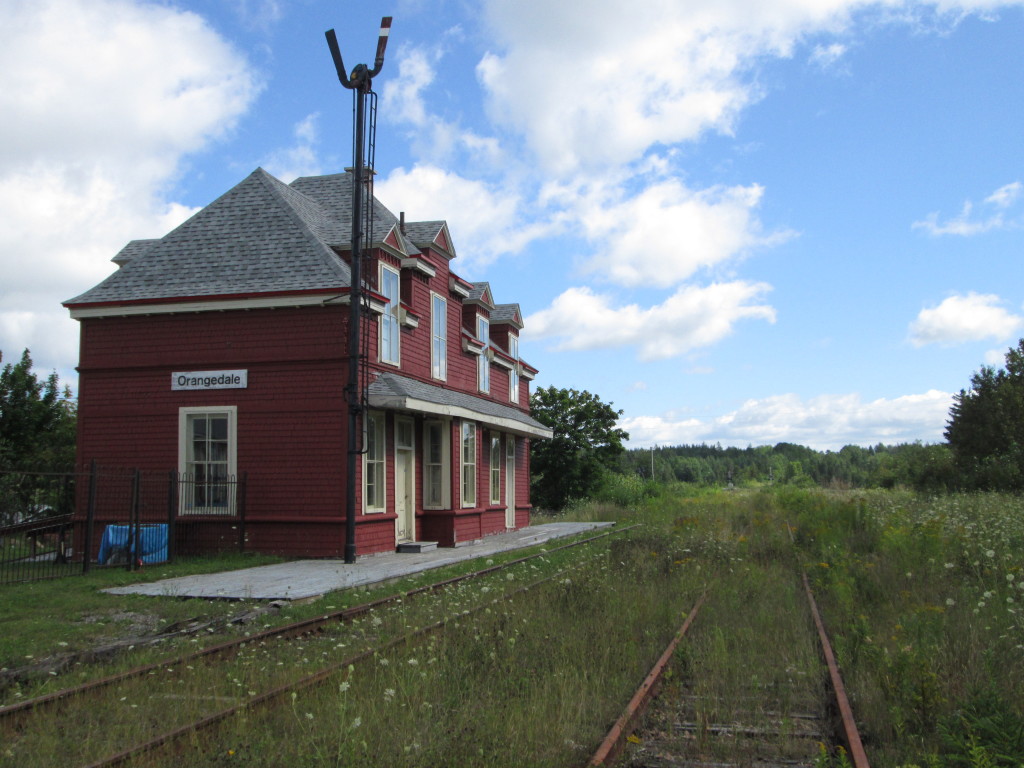By Ted Bartlett

“The stationmaster is long since gone,” lamented the Rankin Family. Sadly, the last revenue train crawled past the legendary station at Orangedale some ten months ago. And if the American owners of the Cape Breton and Central Nova Scotia Railway have their way, the next activity at Orangedale – and indeed along the entire 98 miles of track between St. Peter’s Junction and Sydney – would be the scrappers removing the rails. But that must not be allowed to happen.
The original construction of this rail line was a public undertaking, and it operated for many years as part of the Intercolonial Railway, subsequently absorbed by the Crown corporation Canadian National. CN sold the entire route from Truro to Sydney to a shortline operator in 1993, and there have been several changes of ownership since – during which time there has been considerable physical deterioration of the property as traffic volumes continued to fall for a variety of reasons. In 2014 the current owner, Genesee and Wyoming, announced its intent to abandon the Sydney Subdivision, declaring the operation uneconomic. The company declined to accept renewal of a subsidy offered by the Nova Scotia government.
Last month the Province’s transportation department released a summary of three studies commissioned to investigate various aspects of the issue for the Minister’s Rail Advisory Committee. These included an engineering assessment of the condition of the line and what investment might be required to return it to an acceptable standard; an examination of economic opportunities in Cape Breton, and how they relate to continued availability of rail service; and an analysis of commodities that had until recently been moving by rail and the implications of requiring them to move to highway transport.
The summary appeared somewhat short on concrete solutions, but did make a number of significant observations. While it did not identify any sure-fire fixes that might contribute to substantial traffic growth potential on the Sydney Subdivision, it did point to several chicken-and-egg situations where opportunities might exist if the line were restored to its former condition, and faster (class three) track speeds were once again possible. The report also said the projected port development at Sydney “would likely result in increased rail traffic” – but did not state the obvious: There can be no hope of a container port without a functioning rail line. The document also made it clear that discontinuing rail service had placed a number of Cape Breton enterprises at a significant competitive disadvantage. And – notably – it certainly did not say that the line wasn’t worth saving.
For the railway owners, G&W, it’s all about shareholder value. As far as the company is concerned, it’s in the best interests of their absentee owners to realize the scrap value of the rails, and escape from any future maintenance obligations. But it’s not quite that simple, and it’s certainly not in the best interests of Cape Breton, Nova Scotia or Canada.
This line was a public asset for over 100 years, and when Crown-owned CN turned it over to the initial private operator in 1993, its then-CEO gave a written commitment to the premier of Nova Scotia assuring continuing rail service in the event the new arrangement didn’t work out. The subsequent privatization of CN did not make that commitment go away. If it’s no longer an obligation of the railway company, then the Government of Canada must surely have inherited some responsibility.
So first of all, our new government in Ottawa needs to do the right thing, and negotiate a reasonable settlement with G&W on net salvage value, in return for returning the line to public ownership. We’re not for one moment suggesting that either the Government of Canada or the Province of Nova Scotia should get into the railway business. It’s simply a case of government stepping in to prevent abandonment, pending takeover by a willing and competent operator. It’s a tactic that has been highly successful in other jurisdictions – notably the states of Maine and Vermont.
The track and bridges must be preserved for possible future use while the Cape Breton community works to develop a viable business plan for future operation. The new government was elected on a platform that placed strong emphasis on infrastructure investment, as well as environment-friendly initiatives. There’s already been a strong indication from one re-elected MP that the Liberal campaign promises could benefit this endangered rail line.
The challenge will be to build a convincing case for using federal infrastructure funding to restore the Sydney Subdivision to the condition it was in when CN divested it. This investment could also include upgrades to the line between Truro and Port Hawkesbury – which isn’t exactly in great shape either – and the creation of modest intermodal terminals in Pictou County and the Cape Breton Regional Municipality to encourage more traffic to migrate from overtaxed highways back to rail.
We at Transport Action Atlantic believe there is a way forward. But it will require a vigorous and united effort by the CBRM and the island business community to make it happen. Many communities from coast to coast will be seeking a slice of the new government’s infrastructure pie, and Cape Breton’s case will need to be a compelling one indeed. But once again – the all-important first step is to ensure that the line is not torn up in the name of shareholder value.
“In Canada,” said the prime minister-designate, “better is always possible.” Will the Orangedale whistle be heard again?
Ted Bartlett is president of Transport Action Atlantic.





